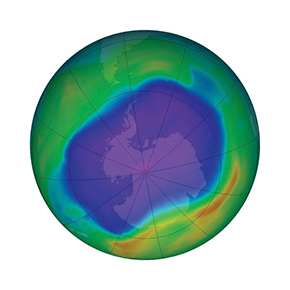
NASAOzone layer (in blue): still under attack by carbon tetrachlorideNASA
It was thought that the substances that destroy the ozone layer – which filters the sun’s incoming ultraviolet rays and thus prevents their damaging effects, including skin cancer – had stopped being emitted for good, as determined by the international agreement signed in 1987 and known as the Montreal Protocol. Apparently, that is not the case. A team of NASA researchers has discovered that the Earth’s atmosphere contains an elevated amount of carbon tetrachloride (CCl4), one of the substances known to deplete the ozone layer. More specifically, the estimated CCl4 emissions calculated by means of computational mathematical models is 43,000 metric tons per year, or 30% of the highest rates of CCl4 emission before the global ban on the substance (Geophysical Research Letters, August 18, 2014). This CCl4, which was used extensively in refrigerators and air conditioning units before the Montreal Protocol, is probably now coming from industrial leaks, contaminated sites, or unknown sources – in other words, its origin remains unclear. The experts at NASA concluded that if CCl4 emissions between 2007 and 2012 had indeed been zero as reported, the concentration of this compound in the atmosphere should have dropped by 4% per year. However, the actual observed reduction was a much more modest 1%. By running simulations of the globe’s atmospheric chemistry, the researchers – now aiming to identify the source of the unexplained emissions – also concluded that CCl4 may linger in the atmosphere 40% longer than expected.
Republish